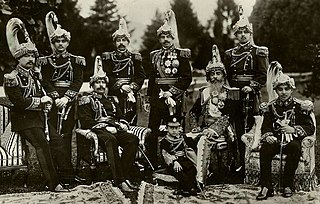
The Rana dynasty was a Chhetri dynasty that imposed authoritarianism in the Kingdom of Nepal from 1846 until 1951, reducing the Shah monarch to a figurehead and making the Prime Minister and other government positions held by the Ranas hereditary. The Rana dynasty is historically known for their iron-fisted rule in Nepal. This changed after the Revolution of 1951 with the promulgation of a new constitution, when power shifted back to the monarchy of King Tribhuvan.
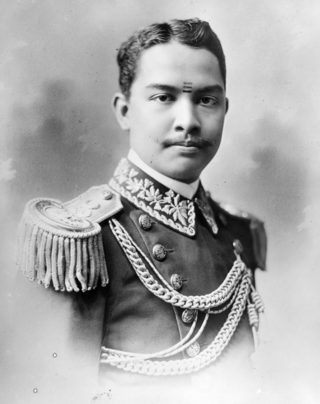
Field Marshal Sir Kaiser Shumsher Jang Bahadur Rana, GBE was a field marshal in the Royal Nepalese Army. He was the third son of Maharaja Sir Chandra Shamsher Jang Bahadur Rana, GCB, GCSI, GCMG, GCVO the fifth Prime Minister of Nepal of the Rana dynasty and Bada Maharani Chandra Loka Bhaktha Rajya Lakshmi.
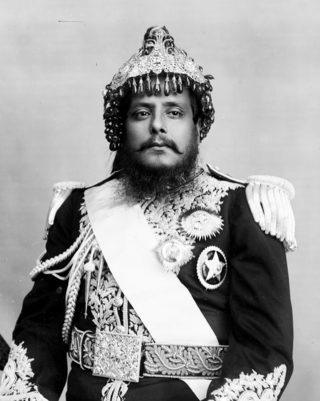
Commanding General Shree Maharaja Sir Bir Shumsher Jung Bahadur Rana was the 11th Prime Minister of Nepal. He is remembered as a statesman who made reforms and infrastructure improvements. Bir Shamsher Jung Bahadur Rana was known as Kailay in his childhood; this name was given by Jung Bahadur. His mother was daughter of Pahalman Singh Basnyat and sister of Lalitman Singh Basnyat. His mother died at his birth and he was taken care of by Putali Maharani, wife of Jung Bahadur. He spent his childhood at Thapathali Durbar.
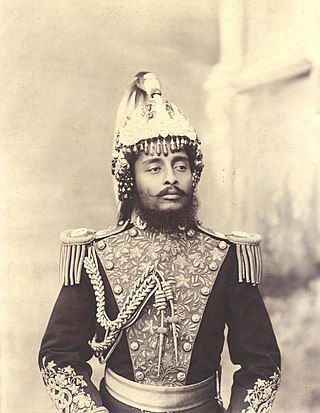
Field-Marshal His Highness Maharaja Sri Teen Chandra Shumsher Jung Bahadur Rana was the Prime Minister of Nepal from the Rana dynasty. He served in this capacity from 27 June 1901 to his death in 1929 after he successfully deposed his liberal and reformist brother Dev Shamsher. Although generally perceived as despotic and conservative, he is credited with several reforms including the abolition of slavery and establishing the Nepal-Britain Treaty of 1923, which recognised Nepal as an independent nation and an ally of Britain.
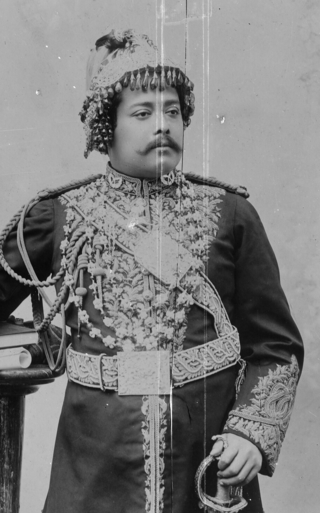
Sri Maharaja, Dev Shumsher Jung Bahadur Rana was the Prime Minister of Nepal for 114 days in 1901. He was also the King of Lamjung and Kaski.

The Order of the Sacred Tripod, also referred to as the Order of the Precious Tripod or Pao Ting, is a military award of the Republic of China. It was created on 15 May 1929 by Chiang Kai-shek for significant contributions to national security. The order is organized into nine grades. The central design of the order's insignia is an image of a tripod surrounded by golden rays. The symbolism of this is that as the tripod is considered a national treasure, so too is the recipient of the order.
The Nepal–Tibet War of 1855–1856 was fought in Tibet between the forces of the Tibetan government and the invading Nepalese army, resulting in huge loss of money and manpower for Tibet and Nepal. In 1856 the war ended with the Treaty of Thapathali.
Maharaj Adhirajkumar Chandrarup Shah was the youngest son of Prithvipati Shah and Rani Kulangavati. He is known in the history of Nepal for cleverly settling power struggle in the Royal house of Gorkha between Dal Shah and Udyot Shah after the death of their older brother Birbhadra Shah. Chandrarup Shah was appointed as the Regent for his nephew Maharaj Nara Bhupal Shah
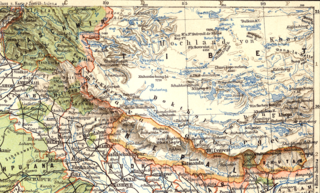
The Nepal–Britain Treaty was first discussed in 1921 and the final treaty was signed on 21 December 1923 in Singha Durbar. The treaty was the first formal acknowledgement by the British that Nepal, as an independent nation, had the right to conduct its foreign policy in any way it saw fit and was considered to be “a great achievement of 25 years of Chandra Shumsher’s diplomacy.” The treaty was recorded in 1925 in the League of Nations.

The banishment of Buddhist monks from Nepal was part of a campaign by the Rana government to suppress the resurgence of Theravada Buddhism in Nepal in the early the 20th century. There were two deportations of monks from Kathmandu, in 1926 and 1944.
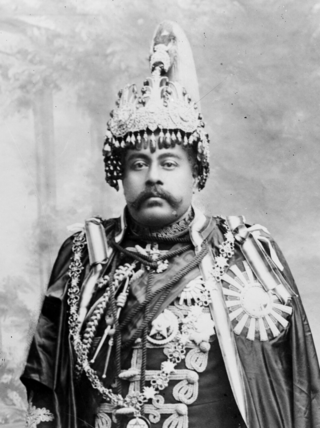
Field Marshal Shri Shri Shri Maharaja Sir Juddha Shumsher Jung Bahadur Rana GCB GCSI GCIE was the Prime Minister of Nepal from 1 September 1932 to 29 November 1945 as the head of the Rana dynasty.
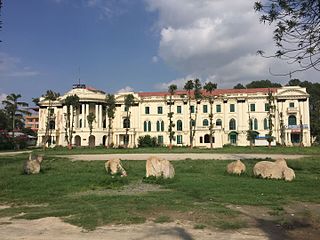
Sita Bhawan is a Rana palace in Kathmandu, the capital of Nepal. The palace complex, located east of the Narayanhity Palace, was incorporated in an impressive and vast array of courtyards, gardens and buildings. Sita Bhawan was built by Bhim Shamsher Jang Bahadur Rana in 1929 for his wife, Her Highness Sri Teen Sita Bada Maharani Deela Kumari Devi.

Harihar Bhawan is a Rana palace in Patan, the capital of Nepal. The palace complex, located west of the Shree Durbar, was incorporated into a vast array of courtyards, gardens and buildings.

Shree Durbar is a Rana palace in Kathmandu, Patan, Nepal the capital of Nepal. The palace complex, located east of the Lazimpat Durbar next to Patan Dhoka, was incorporated in an impressive and vast array of courtyards, gardens and buildings. Sri Durbar was built by Chandra Shumsher JBR in 1927.

Dhir Shumsher Kunwar, after 1848 known as Dhir Shumsher Kunwar Ranaji or Dhir Shumsher Jang Kunwar Ranaji or shortly Dhir Shumsher Rana posthumously known as Dhir Shumsher Jang Bahadur Rana, was a Nepalese politician, army general, and minister of state. He served as the Commander-In-Chief of the Nepalese Army from 1879 to 1884.
Krishna Bahadur Kunwar, after 1848 CE known as Krishna Bahadur Kunwar Rana, was a Nepalese politician, administrator, military general and minister of state. He served as the acting Prime Minister of Nepal upon the demise of his elder brother Bam Bahadur Kunwar from 25 May 1857 to 28 June 1857. He also served as the Commander-In-Chief of the Nepalese Army between 1857 and 1862.

Rana Shumsher Rana was the Commander-In-Chief of the Nepalese Army from March 1887 to June 1887.
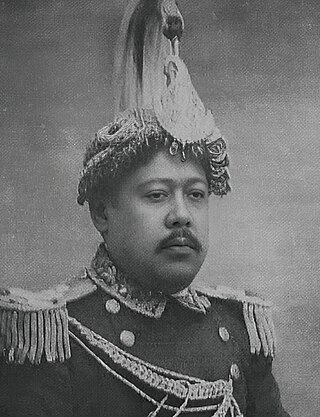
Dambar Shumsher Jung Bahadur Rana (Nepali: डम्बर शमशेर जङ्गबहादुर राणा; also known as Sano Maila ; 1859–1922 was First Nepalese Photographer, Military General, and Courtier in the Kingdom of Nepal.
Jagdish Shumsher Rana was a Nepalese writer and politician. In 1981, Rana was awarded the Madan Puraskar.

Lieutenant-General Sir Krishna Shumsher Jung Bahadur Rana was a Nepalese diplomat who served as the Nepalese Ambassador to the United Kingdom from 1935 to 1939.

















